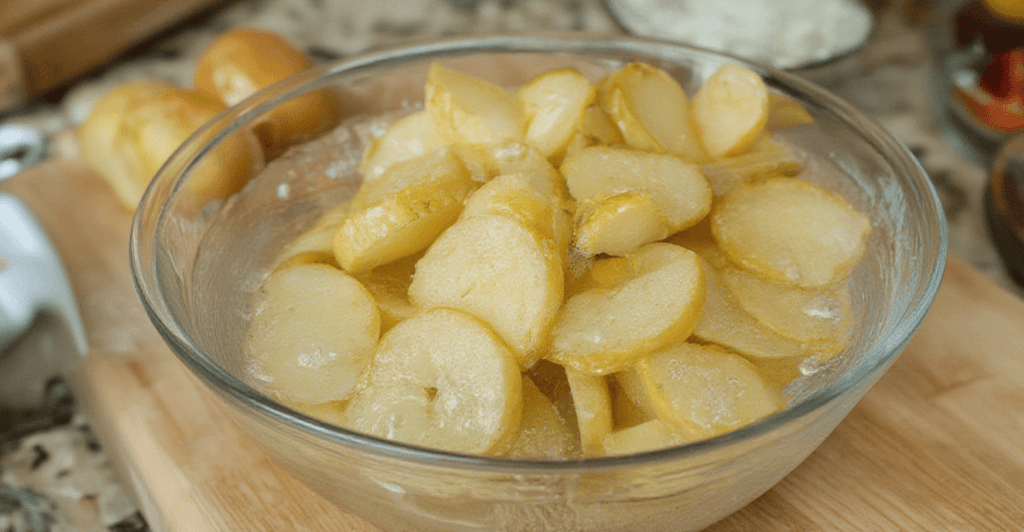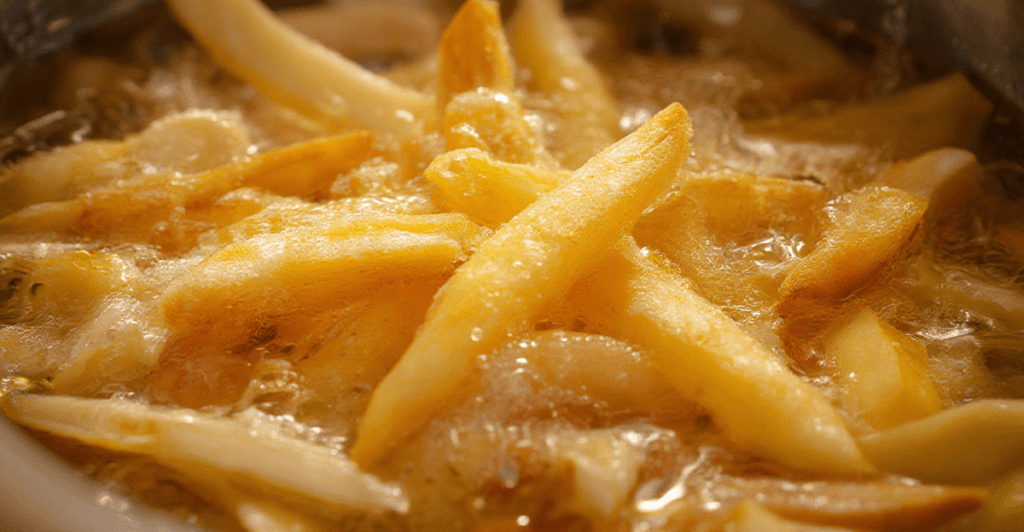Introduction
Why Do You Soak French Fries in Water Before Frying? French fries, a beloved side dish, owe their crispy exterior and fluffy interior to more than just frying technique or oil choice. The secret often lies in a crucial first step: soaking the potatoes in water. But why is this necessary?
This article dives into the science and practical reasons behind soaking French fries in water before frying. From removing excess starch to ensuring even cooking, you’ll learn why this step is a must for crispy, golden fries every time. By understanding the benefits of soaking, you can elevate your homemade fries to restaurant-quality perfection.
The Science Behind Soaking French Fries
When making French fries, soaking them in water might seem like an unnecessary extra step. However, there is solid science behind this practice. Let’s break it down into simple ideas.
The Role of Starch in Potatoes
Potatoes naturally contain a lot of starch, especially on their surface. This starch is a big factor when it comes to how the fries cook. If there’s too much starch left on the potatoes, it can cause a few problems
First, the fries may stick together during frying, making it harder to cook them evenly. Second, excess starch can lead to uneven browning, giving you fries that look patchy instead of having that perfect golden color.
By soaking the potatoes in water, you can wash away much of this starch. The water pulls the starch out of the potato slices, leaving them better prepared for frying.
The Benefits of Removing Starch
Getting rid of some of that starch gives your fries two major advantages
- Even Crispiness
When you soak French fries in water, it helps create an even, crispy coating on the outside. This happens because there’s less starch to burn or clump together during frying. - No Sticking
Soaked fries are less likely to stick to one another in the hot oil. This is especially important if you’re making a large batch and want them to cook evenly.
Why Do You Soak French Fries in Water Before Frying? Soaking is a simple trick to avoid frying issues and achieve a satisfying crunch in every bite.
Achieving the Perfect Texture with Soaking

The texture of French fries is what sets them apart. Everyone loves fries that are crispy on the outside but soft and fluffy on the inside. Soaking the potatoes helps you achieve this balance.
Crispiness on the Outside
When you fry soaked potatoes, their outer layer dries faster, helping it crisp up beautifully. Without soaking, the starch on the surface can cook too quickly, leaving you with fries that are either soggy or too dark in spots.
Soaking creates a cleaner surface, which helps the fries brown evenly and develop that signature crunch.
Fluffiness on the Inside
Soaking also hydrates the potato slices. This means that the moisture inside the fries stays locked in during cooking. As a result, the center of the fries becomes soft and tender.
Think about the perfect French fry: it’s all about contrasts. Soaking helps you create fries with a crispy shell and a melt-in-your-mouth core.
Now that we understand why soaking is so important, the next question is: how long should you soak your fries? In the next section, we’ll explore how soaking time and water temperature can make a difference. Let me know when you’re ready!
How Long Should You Soak French Fries?
Now that we know soaking French fries in water is important, you might wonder: how long should you actually soak them? The answer depends on the kind of fries you want and the time you have. Let’s explore the options.
Short Soaks vs. Long Soaks
Some recipes call for soaking French fries for just 15–30 minutes, while others recommend leaving them in water for several hours or even overnight. Both methods work, but they give slightly different results.
- Short Soaks (15–30 minutes):
If you’re short on time, a quick soak will still remove a good amount of starch. This can improve crispiness and prevent sticking. However, shorter soaks may not fully hydrate the potatoes, so the inside might not be as fluffy. - Long Soaks (1–8 hours):
Soaking for a longer period allows more starch to be removed. It also hydrates the potatoes more thoroughly, making them extra soft and fluffy inside. If you’re aiming for restaurant-quality fries, an overnight soak is a great option.
Cold Water vs. Warm Water
The temperature of the water you use for soaking also makes a difference.
- Cold Water:
Most recipes recommend soaking fries in cold water. Cold water slows down any chemical changes in the potatoes and helps keep them firm. It’s the best choice for maintaining the fries’ shape and texture. - Warm Water:
If you’re in a rush, you can use slightly warm water to speed up the process of starch removal. However, be careful not to use hot water, as it can partially cook the potatoes and affect their final texture.
What Happens if You Soak Too Long?
Why Do You Soak French Fries in Water Before Frying? French fries, loved for their crispy exterior and fluffy interior, rely on more than just frying technique or oil choice. Soaking potatoes in water is a key step to remove excess starch and improve texture. However, soaking too long—over 24 hours—can cause problems, like waterlogged potatoes losing flavor and falling apart during frying.
Why Do You Soak French Fries in Water Before Frying? Now that you know how long to soak fries and the type of water to use, you might wonder if soaking is always necessary. Next, we’ll explore when you can skip this step and consider alternatives. Ready to dive in?
Do All French Fries Need Soaking?
Soaking French fries in water is a widely recommended step, but is it always necessary? Not every type of fry requires soaking, and there are other methods you can try if soaking isn’t your preference. Let’s break it down.
When You Can Skip Soaking
While soaking is helpful for most homemade French fries, there are times when you might not need to do it.
- Using Pre-Frozen Fries
If you’re cooking store-bought frozen fries, soaking isn’t required. These fries are usually pre-blanched and partially cooked during processing, so the extra starch has already been removed. - Low-Starch Potatoes
Certain potato varieties naturally have less starch, which means they don’t need as much preparation. Waxy potatoes, like red potatoes or fingerlings, are lower in starch and can often be fried directly without soaking. However, these potatoes might not get as crispy as high-starch ones like Russets. - Thin-Cut Fries
If you’re making very thin fries, like shoestring fries, soaking may not make a big difference. These fries cook quickly, so they don’t retain as much moisture or starch during frying.
Alternatives to Soaking
If you want to skip soaking but still want crispy, golden fries, here are some other techniques to try:
- Steam Blanching:
You can steam or boil the potato slices briefly before frying. This helps to pre-cook the interior and reduce the starch on the surface. It’s an excellent option if you don’t have time for soaking. - Parboiling:
Another option is to parboil the potatoes in salted water for a few minutes. This process softens the inside and makes the outer layer easier to crisp during frying. - Using Cornstarch or Flour:
Instead of soaking, you can toss your fries in a thin layer of cornstarch or flour before frying. This creates a crispy coating without the need for soaking.
The Downsides of Skipping Soaking
If you skip soaking altogether, you might notice some differences:
- The fries may stick together during frying because of the extra starch.
- The outer layer may not brown evenly, leaving some fries with pale or dark spots.
- The fries may lack the signature crispy exterior and soft interior that soaking helps achieve.
Why Do You Soak French Fries in Water Before Frying? While skipping soaking is an option, it’s one of the easiest and most effective ways to achieve perfectly crispy and fluffy French fries.
Step-by-Step Guide to Preparing French Fries with Soaking

Now that we’ve covered why soaking French fries in water is important and when it’s necessary, let’s walk through the entire process. This step-by-step guide will help you make perfect homemade fries that are crispy, golden, and delicious.
Selecting the Right Potatoes
The first step to great fries is choosing the right type of potato. Not all potatoes are the same, and some work better for frying than others.
- Best Potatoes for Frying:
High-starch potatoes like Russet potatoes are the top choice. They have a dry texture that makes them ideal for soaking and frying. They crisp up nicely while staying fluffy on the inside. - Other Good Options:
Yukon Gold potatoes are another excellent choice. They have slightly less starch than Russets but still work well for fries.
Avoid waxy potatoes like red potatoes or new potatoes, as they don’t crisp up as much due to their lower starch content.
Preparing the Potatoes
Once you’ve chosen the right potatoes, it’s time to get them ready:
- Wash the Potatoes:
Rinse the potatoes under cold water to remove any dirt or debris. - Peel (Optional):
You can peel the potatoes if you want smooth, uniform fries. However, leaving the skin on can add extra flavor and texture. - Cut into Even Slices:
Use a sharp knife or a fry cutter to slice the potatoes. Aim for uniform thickness to ensure they cook evenly. A common size is about 1/4-inch thick.
The Soaking Process
Now comes the crucial step: soaking the potato slices in water.
- Fill a Large Bowl with Cold Water:
Place the potato slices into a large bowl of cold water. The cold water helps remove excess starch and keeps the potatoes from turning brown. - Soak for 1 to 8 Hours:
For best results, soak the fries for at least 1 hour or, ideally, overnight. If you’re short on time, even a 30-minute soak will make a difference. - Rinse the Potatoes:
After soaking, drain the water and rinse the potato slices under cold water one more time to remove any remaining starch. - Dry Thoroughly:
Use a clean kitchen towel or paper towels to pat the potato slices dry. Removing excess water is crucial because wet potatoes can cause oil to splatter during frying.
Frying for Maximum Crispiness
After soaking and drying, it’s time to fry the potatoes to perfection.
- Heat the Oil:
Use a deep pot or fryer and heat your oil to 325°F (160°C) for the first fry. Neutral oils like canola or peanut oil work best. - First Fry (Blanching):
Fry the potato slices in small batches for 4–5 minutes. This step cooks the inside without browning the outside. Remove the fries and let them cool. - Increase the Heat:
Raise the oil temperature to 375°F (190°C) for the second fry. - Second Fry (Crisping):
Return the fries to the hot oil and fry until golden brown and crispy, about 2–3 minutes. - Drain and Season:
Remove the fries from the oil and let them drain on a paper towel. Sprinkle with salt or your favorite seasonings while they’re still hot.
Serving Your Perfect Fries
Once your fries are ready, serve them immediately for the best taste and texture. They pair perfectly with ketchup, mayonnaise, or any dipping sauce of your choice.
Now that you know how to prepare French fries step by step, let’s answer some common questions about soaking and frying
FAQs
What are onion fries called?
Onion fries are commonly called onion strings or onion straws. These are thin slices of onions, usually coated in a light batter or seasoned flour, and deep-fried until crispy. If the onions are cut into circular shapes, they are known as onion rings, a popular snack or side dish served with dips like ketchup or ranch dressing.
What are French fried onions made of?
French fried onions are made from thinly sliced onions that are lightly coated in a mixture of flour, seasonings, and sometimes breadcrumbs, then deep-fried until crispy. The coating often includes salt, pepper, and spices to enhance flavor. These crispy onions are widely used as a crunchy topping for casseroles (like green bean casserole), salads, soups, and burgers.
What is the secret ingredient in McDonald’s French Fries?
The secret ingredient in McDonald’s French fries is natural beef flavoring. While the fries are primarily made from potatoes, McDonald’s uses a flavor derived from wheat and milk to recreate the savory taste that was originally achieved by frying in beef tallow. This addition gives the fries their signature flavor. Additionally, McDonald’s fries are partially cooked and flash-frozen before arriving at the restaurants, where they are fried again to achieve their iconic crispiness and golden color.
Conclusion
Soaking French fries in water before frying is a simple but essential step to achieve crispy, golden, and delicious results. By removing excess starch, soaking helps the fries cook evenly, prevents them from sticking together, and ensures a perfect balance between a crispy exterior and a fluffy interior. Whether you’re preparing fries at home or experimenting with onion fries or other toppings, understanding the science and techniques behind this process can elevate your cooking.
With the right type of potato, a proper soak, and a little patience, you can create fries that rival your favorite restaurant’s version. For those curious about variations like onion fries or the secrets of McDonald’s iconic flavor, knowing the ingredients and methods adds a fun twist to your culinary journey. So, the next time you’re in the kitchen, give soaking a try and taste the difference for yourself!

